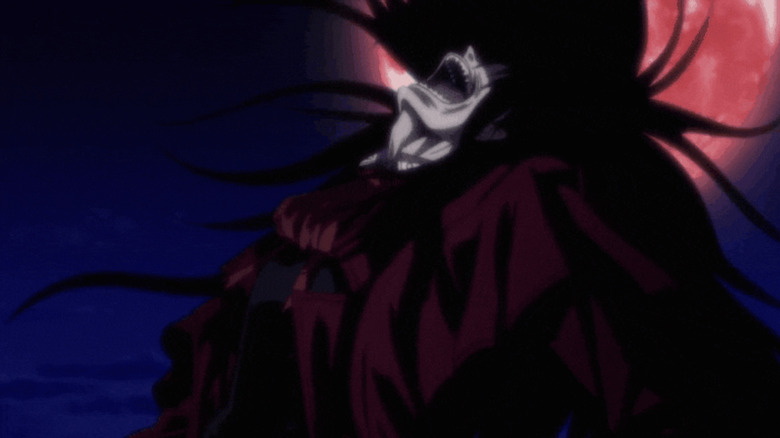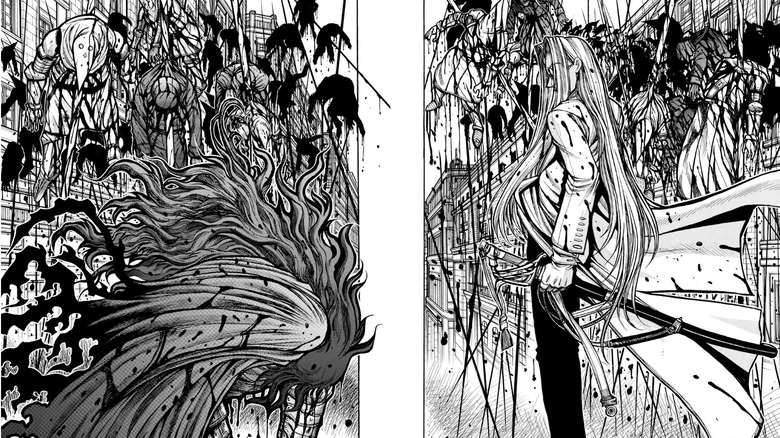Hellsing Is The Dracula Story Renfield Wishes It Was
I saw "Renfield" this weekend — but based on the box office returns, I'm one of the few who did. I understand why, since I didn't enjoy the experience. Why is the movie an action-comedy instead of a horror-comedy? Why is it set in the modern day, especially when the opening teases a "Young Frankenstein" style homage to classic, black-and-white Universal Horror?
To read more about the failings of "Renfield," I'd point to /Film's own review courtesy of Chris Evangelista. And if you want a better action-heavy, modern-day twist on Dracula, I recommend Kouta Hirano's manga "Hellsing" and its anime adaptations ("Hellsing: Ultimate").
Published from 1997 to 2008, the Dracula of "Hellsing" is unrecognizable. He now goes by Alucard, for one, and while still a creature of the night, he hunts his own kind, not ingenues or estate lawyers. Why? Because Alucard serves at the behest of Sir Integra Fairbrook Wingates Hellsing, a descendant of Abraham and head of the ghoul-hunting Hellsing organization. Armed with two enormous handguns and draped in a debonair red long coat, Alucard is Hellsing's ultimate line of defense against dangerous adversaries, from fanatical Catholics to a revenant Third Reich.
The premise of "Hellsing" is like an inversion of "Renfield," for they both upend the master-servant relationship that the Lord of Vampires has always been on top of. In "Renfield," Dracula's human familiar rebels. In "Hellsing," Dracula has become humankind's servant and protector.
'Once a vampire came to England...'
"Dracula" is in the public domain, meaning both Bram Stoker's novel and its titular villain have been reinterpreted time after time. What sets "Renfield" and "Hellsing" apart is that they don't just use the Dracula character, but position themselves as outright sequels.
"Renfield" director Chris McKay told Collider that his movie was written as a follow-up to the 1931 "Dracula," directed by Todd Browning and a cornerstone of Universal Horror. That's the reason for the black-and-white opening I previously mentioned; it's a recreation of the scene where Renfield meets the Count in Browning's film, and Nicolas Cage perfectly imitates Bela Lugosi. It doesn't speak well of Renfield that its greatest moment belongs to another movie.
"Hellsing," on the other hand, follows up Stoker's novel; Alucard still dreams of his defeat at Van Helsing's hands. Like Francis Ford Coppola's 1992 "Dracula" adaptation, the series also explicitly interprets Dracula as Vlad "The Impaler" Tepes. Chapter 68/episode 9 of "Ultimate" shows Alucard's past waging war against the Turks as a prince of Wallachia. After he leads his followers to defeat, he drinks their spilled blood to save himself from beheading and becomes a vampire.
The story structure of Stoker's "Dracula" is echoed in "Hellsing." To prepare for their invasion of England, the Nazi group Millennium hijacks a British aircraft carrier, the Eagle. Alucard arrives and slaughters the Millennium forces, but winds up trapped at sea — the Nazis' plan all along. Alucard arrives at the battle late, but arrive he does in chapter 57/episode 8. As he did 100 years before, Dracula comes to England on a ghost ship; the narration even compares the Eagle to that original ghost ship, the Demeter.
One last twist: The source of Millennium's vampires? The group's doctor excavated Mina Harker's corpse and extracted Dracula's dormant essence.
'The bird of Hermes is my name, eating my wings to keep me tame'
More than anything, "Renfield" is a comedy. This isn't necessarily a bad choice, but what hurts the movie is that it seems to have no interest whatsoever in the horror of its source material. It's never even shot like a horror movie, with even heavily shadowed scenes being steeped in the teal/orange color contrast all too common in movies these days.
The action component of the film is even more ill-fitting and worsened by some truly abysmal CGI blood. Dracula feels less like an inescapable force of nature and more like a Thanos-esque supervillain who can be overcome if the good guys come together. The action-comedy tone McKay seems to be going for is John Carpenter's "Big Trouble In Little China," another movie about a crime syndicate getting involved in dark magic with a hapless protagonist. However, the attempt falls flat.
"Hellsing" has its moments of surreal humor, with a simplified art style to reflect the tonal shift (these are the parts of the manga that translate the worst to the anime). Even so, it never forgets about the type of story "Dracula" is supposed to be. While the manga and anime are about action first and foremost, the violence is rooted in horror. Enemies run in sheer fright from Alucard's invincibility while the blood and mutilation reach truly grotesque heights.
Even though the story is drawn rather than filmed, the gore feels ironically more real than it does in "Renfield." "Hellsing" has a simple conceit — what if Dracula himself was an action hero? — and that's terrifying.
There's only one police girl for Dracula
The weakest link of "Renfield" is Rebecca Quincey (Awkwafina), a New Orleans police officer who reignites Renfield's humanity. I understand why the script uses a human love interest to facilitate Renfield's arc, but in practice, Rebecca only undermines that journey. The film gives her a whole subplot about investigating the local mob and her father's death, which is distractingly out of place while taking precious time away from Renfield and Dracula themselves. Awkwafina is eye-rolling and unfunny in what might be her worst performance to date.
In a coincidence that demands comparison, "Hellsing" has a young policewoman as a supporting character too. In chapter 1, Alucard kills a vampire priest who ravaged a rural British village. Police were sent in first and only one survived — a young woman named Seras Victoria. The priest uses Seras as a human shield, so Alucard just shoots both of them and then turns Seras into a vampire to save her.
Seras (or "Police Girl" as her new master calls her) is a reinvention of the archetype created by Lucy Westenra and Mina Harker from Stoker's novel; a young, blonde, virginal woman who falls under Dracula's spell. Rather than being a victim, though, Seras' transformation empowers her — though she does take half the story to embrace it. During "Hellsing," Seras falls for Pip Bernadotte, a mercenary captain recruited by Hellsing to shore up their forces. Pip meets his end in chapter 53/episode 7 thanks to the Millennium vampire Zorin Blitz, but Seras drinks his blood (her first taste of it) and avenges his murder.
Rather than a superfluous character, Seras succeeds in humanizing Alucard; their relationship winds up less master/servant and more father/daughter. When it comes to bringing out a monster's heart, "Hellsing" beats "Renfield."



